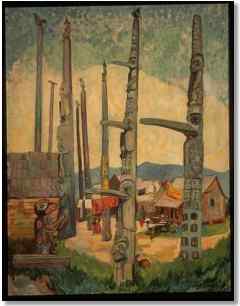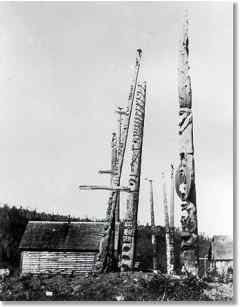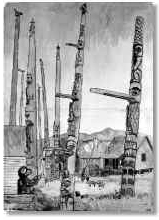Kitsegyukla



"The adaawk (oral histories) describe the ancient migrations of the house, its acquisition and defence of its territory, and major events in the life of the house, such as natural disasters, epidemics, war, the arrival of new peoples, the establishment of trade alliances, and major shifts in power. . . . The ayuuks, or crests, depicted on poles and on ceremonial regalia also arise out of events in the history of the house as described in the adaawk.
Sterritt et al 1998:12
The ayuuks shown on the extreme right of Carr's painting are, from top to bottom:
- Wood of Hemlock (Rafters of the House), depicted by the cross-hatched cylinder
- Split Person almost always rendered with the central face divided by a vertical split
- Weneel, a mythical long-nosed bird
- Three Human Beings standing shoulder to shoulder with groundhogs under their arms
- The Ladder, depicted by parallel rows of notches
The pole honours a Chief named Weegyet and records highlights from his mythic and real history which, from the Gitksan point of view, is a single continuum.
The saga of the house recounts how ancestral hunters encountered and conquered a bird monster as they moved into groundhog hunting territory. They were trapped by a rock slide and extricated themselves using a ladder constructed from a log with notched footholds. They safely reached their home on a nearby mountain top. Built into the rafters of the house are drying racks for smoke-curing fish and game.
Adapted from Barbeau 1929:105
Continue on with Kitsegyukla
See more paintings of Kitsegyukla
See more photographs of Kitsegyukla
|

